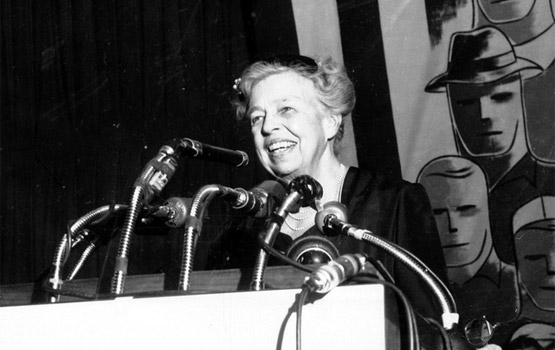
Eleanor Roosevelt via Yes! Magazine
Eleanor Roosevelt speaks at a podium at an AFL-CIO event. Photo by the Kheel Center for Labor-Management Documentation and Archives.
Let the record show that the Eleanor you see in the film Hyde Park on Hudson is an incomplete charicature, so says historian Peter Dreier in a Jan. 24 2013 essay in Yes! Magazine:
“…. In reality, Eleanor’s life—before she met FDR, during the 13 years she served as first lady, and after FDR died in 1945—was filled with important public controversies, including her activism around such issues as workers’ rights, civil rights, women’s rights, and human rights. She became FDR’s most important, and most progressive, advisor. FDR was the most powerful president in American history, and Eleanor (who died in 1962) wielded her own power, sometimes behind the scenes but often in public, breaking the mold for first ladies. No first lady before or since—not even Hillary Clinton—has had as much influence while her husband was president.
Eleanor consistently pushed FDR to the left on key issues and appointments. The left-leaning members of FDR’s inner circle (including Labor Secretary Frances Perkins, Agriculture Secretary and later Vice President Henry Wallace, and Harry Hopkins, who formulated and ran many New Deal relief programs) often conspired with Eleanor to make sure he heard the views of progressive activists.
Throughout her life, Eleanor fought on behalf of America’s—and the world’s—most vulnerable people. Over time, she became friends with a widening circle of union activists, feminists, civil rights crusaders, and radicals whose ideas she embraced and advocated for, both as FDR’s wife and adviser and as a political figure in her own right…”